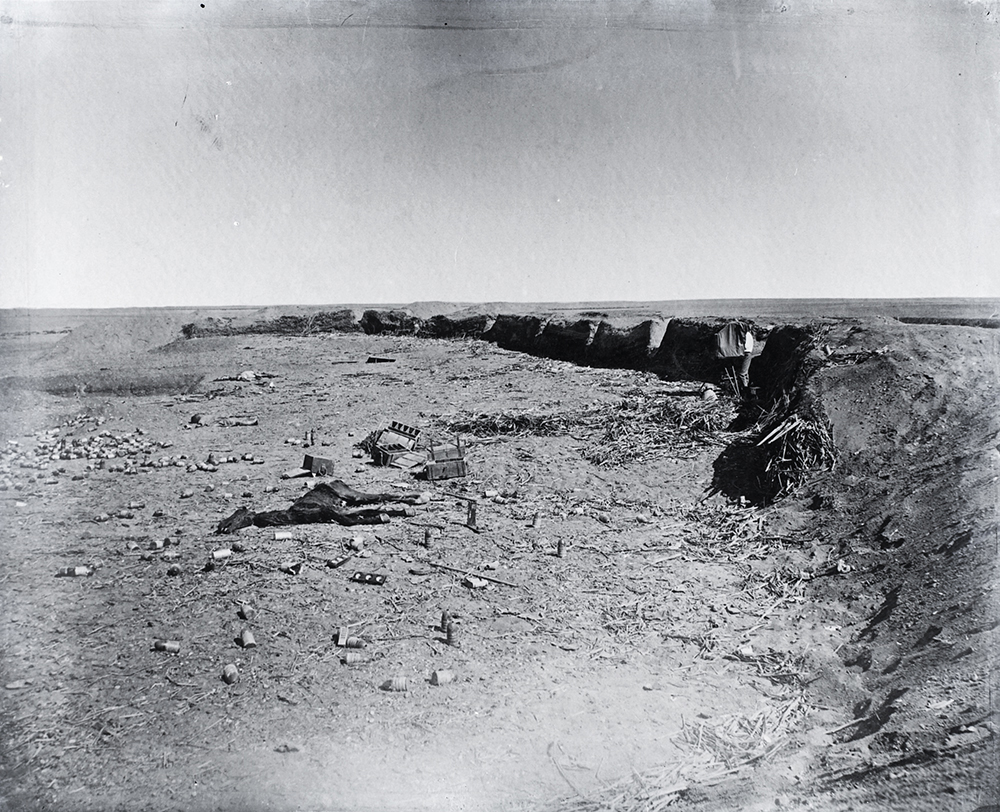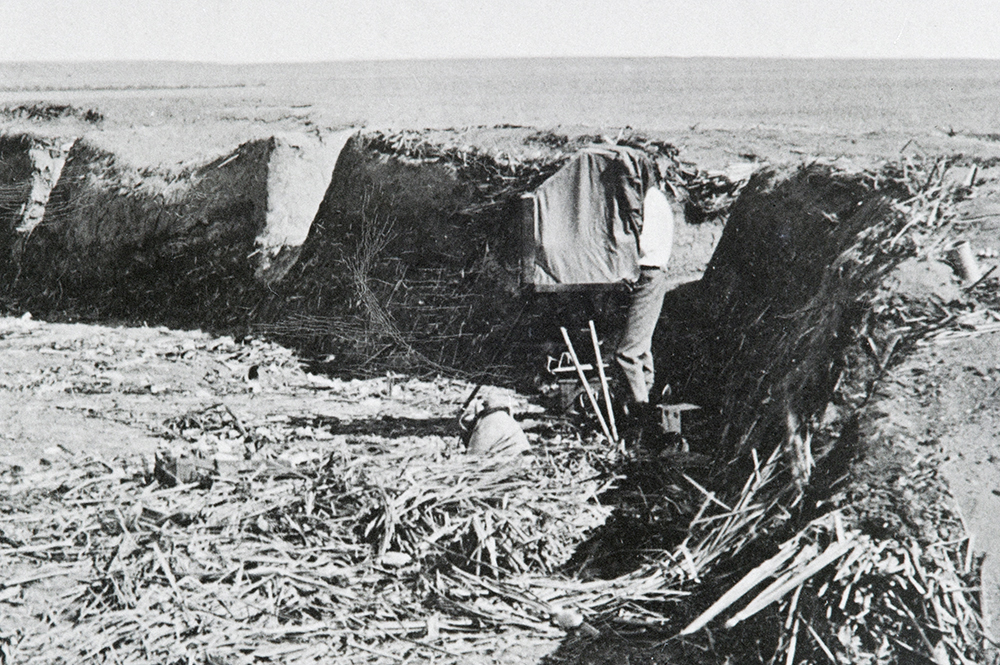BL-n087 is a photograph of a photographer taking a photograph. You may be able to identify the photographer at work, if you recognise the photograph he probably took here: a scene including a human corpse and battle debris – the aftermath of an engagement, at a makeshift earthworks fort, taken during or just after the Boxer Uprising. One can imagine the hot pungent working conditions of this unidentified proto-photojournalist.
It is possible that the photographer operating the large view camera on a tripod (see BL-n088, a detail of BL-n087) is the American James Ricalton, who “was widely acclaimed as one of the most important (certainly most popular) photographers of his time.” (Source: ‘James Ricalton’s Photographs of China during the Boxer Rebellion’ by Christopher J. Lucas)? Ricalton took many stereoscope photographs in China in 1900, published by Underwood and Underwood.
BL-n087 is a copy of a photograph, made on a glass plate negative – and is one of a set of 59 negatives, being photographs of various items assembled and then copied on a copy stand with a dry plate camera, possibly in about 1902-15, that together illustrate the story of the siege of the Legations in Peking (June-August 1900). The items copied include photographs from at least two different albums, also unmounted photographs (including some by Reverend Charles Killie), notes and letters sent during the siege by Claude Macdonald, Colonel Shiba, Herbert Squires, Admiral Sir Edward A. Seymour and General Alfred Gaseley, and a plan of Peking and other printed magazine illustrations (from the Royal Engineers Journal and the Illustrated London News), and also the diners signatures on back of a menu for a ‘Lest We Forget’ dinner. It can be surmised that this narrative set was created to make prints for exhibition, or to illustrate a publication. The glass negatives are in a wooden box at the Billie Love Historical Collection picture library.
For a lighter set of pictures of photographers at work, see http://www.flickr.com/photos/20939975@N04/3135648340/in/set-72157603425770983/



John David Zumbrun owned Camera Craft, Legation District, Peking, Old China circa 1910-1929. Distributor in the city for Eastman Kodak his studio was a gathering place for photographers, travelers, tourists, the Imperial Court, the First Republican government, merchants, diplomats, those assigned to troops in the Legation Quarters, and any seeking portraits of themselves and loved ones, souvenir photos of China, equipment, film supplies and developing of their film. Well known in his day and located at 16 Legation District (outside the Forbidden City) as well as the Peking Grand Hotel (outlet) John Zumbrun’s business flourished, his photos were sought by many, his work appeared in National Geographic, authors incorporated his images into their articles, literature, magazines and books including Juliet Bredon (Peking) and the Thomas Cook & Sons Travel Agency in their Travel Magazines. No stranger to the peoples, places and changing times Zumbrun’s collection includes images from all aspects of Chinese social strata including the Last Emperor PuYi, Dr. Sun Yat Sen, General Yuan Shi Kai, the Imperial Court, local officials, the foreign troops and tourists, shop keepers, farmers, refugees, children, street life, country life and life in the city. He captured the faces and places of a changing China. Because of his shop’s location and his personality one can imagine enjoying many a discussion with fellow photographers. Maybe James Ricalton might have stopped by. Perhaps George Morrison, lecturer, author, photographer, correspondent for a London Newspaper, confidant of Yuan Shi Kai stopped in to make arrangements for Zumbrun to cover the General’s Ceremony at the Altar of Heaven? John Zumbrun “knew China was in his blood”. John met his wife Louise (Red Cross Nurse) on the Great Wall; she bore him two daughters, youngest Louise (now past) and Helen who has graciously allowed his collection to be studied. Our thanks go to all those who have and continue to contribute to an understanding of the time, the place and faces uncovered in the collection which came to “light of day” four years ago (2009) from 3 Steamer Trunks that were carefully prepared and locked away upon Zumbrun’s exit from China in 1929.
I have a small photo album of scenes in China, possibly photos by John Zumbrun. It is inscribed to my adoptive mother: To Veo, From John, December 25, 1923. I am curious, is there a sample of John Zumbrun’s handwriting somewhere?